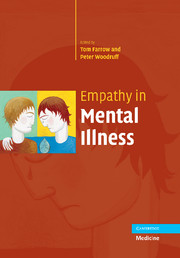Foreword
Published online by Cambridge University Press: 17 August 2009
Summary
Empathy literally means ‘the power of understanding things outside ourselves’ after the Greek empatheia, but has come to imply a reliance on ‘inner feeling’, from the German ein (in) fuhlung (feeling), and even an implied sense of ‘cure’ from ‘em-pathy’ the suffix-pathy meaning a ‘method of cure’. It is after all through examination of our inner feelings that we gain a deeper understanding of ourselves. Our ability to relate to those feelings we see expressed by others depends on an ability to compare them with those we may have experienced ourselves, which allows us to infer ‘what the other person must be going through’. The accuracy of our inference depends upon empatheia.
Much of psychotherapy depends on helping individuals to analyse and hence reach some emotional understanding of their inner world to enable them to relate more adaptively to people and events outside themselves. In this sense there is an assumption that individuals possess the ‘capacity’ to empathize. This capacity may be encouraged and developed through therapy. There is also an assumption that there may be individuals who lack such a capacity or, if they do possess it, may use it in a maladaptive way which can cause difficulties in their relationships. This raises the question of whether the ‘psyche’ or its substrate (the brain) lacks a necessary processing capacity or ‘neural network’ to empathize adequately.
- Type
- Chapter
- Information
- Empathy in Mental Illness , pp. ix - xxiiPublisher: Cambridge University PressPrint publication year: 2007



